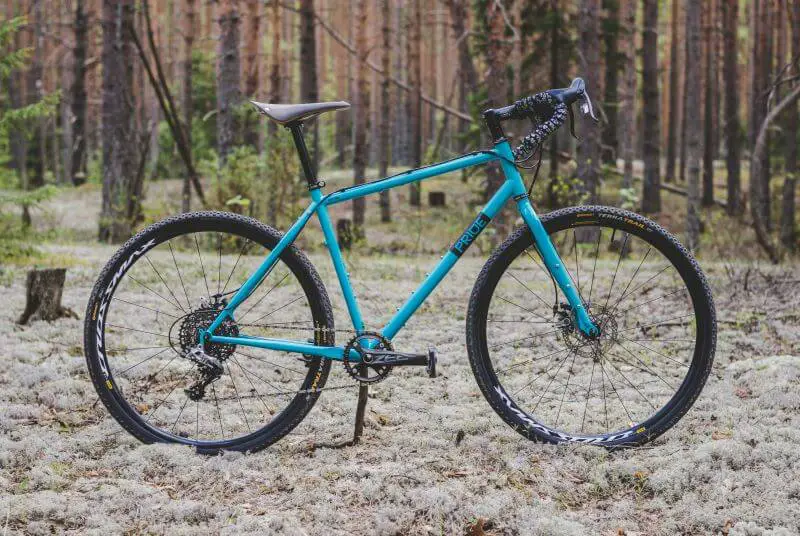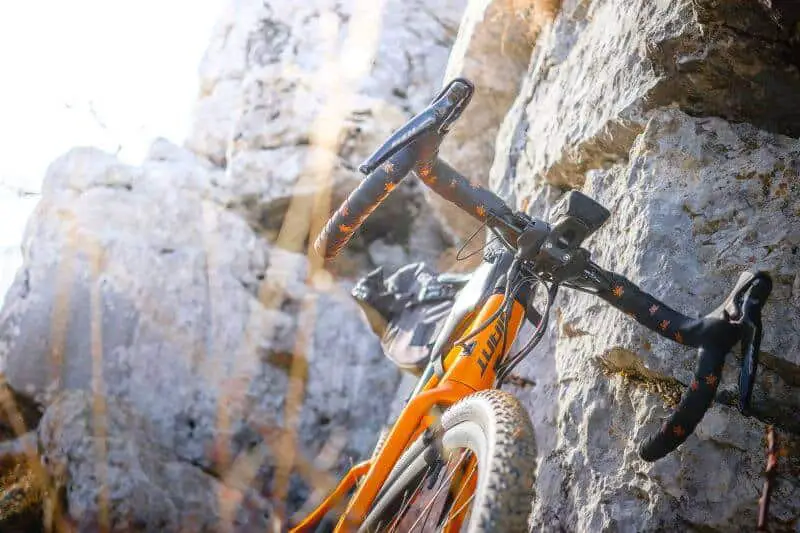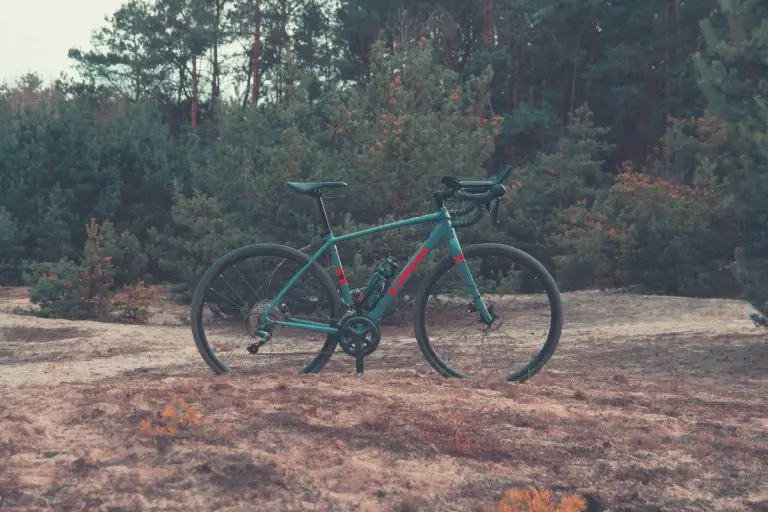Gravel bikes are taking the world by storm and I wanted in on that action. However, given the fact that basically, the whole world is attempting to buy a gravel bike, supplies are short. This made me wonder, “can you convert a road bike to a gravel bike?”.
Skip ordering a new bike and create one for myself? Turns out, you can and the steps needed aren’t complicated nor expensive!
Converting a road bike to a gravel bike will require you to change the tires, wheels, gearing and make a few small changes to achieve the correct riding position for gravel riding.
It won’t be a complete transformation but it will give you the desired results so that you’ll be able to enjoy being able to go off-road when you want to.
Tires
When you’re converting a road bike to a gravel bike, tires are going to be your most important upgrade.
Changing your tires from slick roadie ones to chunkier traction-loving tires is going to give you that much-welcomed extra grip, as well as protecting you from punctures.
When you’re thinking about what type of tires you’re going to use, you will need to think about what type of gravel riding you’re going to be doing. Fancy spending time on well-used towpaths, forest trails, and similar places? Then you should find that big fat slick tires will be ideal in dry conditions.
If rougher gravel and woodland trails are more your things then you’re going to need different tires. Opting for wider, more aggressively treaded tires will give you the grip and control you want.
An off-the-shelf gravel bike is often spec’d with 40mm or wider tires – something you’re not likely to get on a road bike! With race road bikes, you’re looking at around 25 – 28 mm. Endurance gets a bit wider, usually up to around 35mm and cyclocross gets closer at around 40mm.
If you’re planning on going on rough gravel then the minimum width you should be looking at 33mm. That will give you the comfort and control you’ll need (and want!). Just like with road tires, gravel tires come in lots of varieties so it’s important to choose the right tire to suit the conditions.
You may find that you’re limited on tire clearance depending on your road bike so one solution is to fit cyclocross tires. That will give you a better width, around 33mm. They also come with a choice of tread patterns so you can usually find one to fit the style of riding you want to do.
Related article – Best Road Bikes Under $500 – Budget Friendly Options

Wheels
Gravel riding is often tougher on your wheels than road riding is so it’s worth considering swapping out your wheels for something more durable.
Sure, plenty of people use carbon fiber wheels for gravel wheels but investing in some aluminum wheels could be a good option. It means you can hammer down a gravel track without much concern about damaging them.
One thing to keep in mind is the rim width. You’re going to want to ensure that the wider tire is supported sufficiently by using an appropriate rim width.
The downside to having a wider rim is that the tire could end up being wider than the sidewall measurement. Just be sure to keep a decent amount of clearance between your frame and tire. The amount of clearance you’ll need is going to depend on the type of riding you do and how muddy the trails will be.
One way you can increase your tire clearance is by choosing a smaller wheel size. Generally speaking, road bikes have 700c wheels. However, increasingly gravel bikes are designed to be compatible with 650b wheel sizes.
The huge upside to these is that you can run a bigger volume tire, this will give you more comfort and increase the traction without the setup being bigger than 700c.
Going down that route may seem like a no-brainer right now, so let me throw the cat amongst the pigeons! 😂
Road bikes aren’t designed to take smaller wheel sizes and this can lead to some compatibility issues. One hurdle that is difficult to overcome is the impact on bike geometry as reducing the wheel size will reduce the height of the bottom bracket.
Punctures are a pain. Being on gravel inevitably raises your chances of getting a flat so I’d recommend switching to a tubeless setup (I even run mine on the road and it’s increased the comfort).
Related article: Gravel Bike vs Mountain Bike – Best For Off Road Riding?
Contact Points
Handlebars on a gravel bike are more flared at the drop than what you find on road bikes, the idea is that the flare gives you greater control and comfort when you’re on the gravel.
Depending on what suits you, you will have a choice on the angle of the flare, some are mild, some are quite extreme. The wider the drop bar, the more control you tend to have (providing your body can take it!) and you should be able to relax your upper body more.
The geometry of gravel bikes is more relaxed when compared to roads so trying to replicate this is advisable. You can do this by swapping out your stem for a shorter and/or higher one.
The result of this will be that the handlebars will be closer to your body so you’re going to notice an increase in control of the bike – particularly important when you’re taking on woodland trails and you need to be more nimble to avoid coming into contact with nature!
Gravel is rougher than roads, I probably didn’t need to tell you that but you might want to take steps to increase your comfort, changing your handlebar tape to one with more padding can be a good step. This will give you more cushioning when you’re on gravel tracks.

Another thing you can do is get yourself a carbon fiber seat post, this will flex more and absorb some of the impact.
If you ride clipless on your road bike then you might want to consider switching to an SPD setup for your gravel bike.
Why?
Firstly, it’s difficult to walk in road bike shoes anyway, throw in some gravel and it becomes very difficult!
It’s also going to ruin your cleats and nice road shoes very quickly.
Mountain bike or touring bike shoes are designed for rougher conditions so will be less likely to get clogged in muddy conditions too. They also have a recessed cleat so walking in them is much easier.
You may also like to read How To Make Your Bike Seat More Comfortable.
Gearing
On a road bike, the gearing is set for higher speed, smooth changes, and the ability to reach optimum cadence.
The objectives of gravel riding are different so the gearing is different.
You’re going to suddenly come across big steep climbs and a terrain that changes before your eyes (am I selling it to you?). To ensure that you’re able to keep on pedaling throughout all of this, the gearing on gravel bikes tends to be wider and lower.
One way to convert your road bike to have the right gearing is to fit a bigger cassette. This is a quick way to increase your range and get you those lower gears.
You will find that your bike’s manufacturer will have a maximum cassette size depending on the rear derailleur. However, there are a few ways to get around this – Wolf Tooth RoadLink can allow you to use a bigger cassette for example.
There is also the option of changing your chainrings to get smaller sizes, this will increase what you can climb.
If you really want to go for the full conversion, you can fit a gravel-focused chainset to your road bike and this will give you the lower gears easily.
Want some further tips? Check out GCN’s guide to converting your road bike to a gravel bike:
Frequently Asked Questions
Are gravel bikes slower than road bikes?
The wider tires on a gravel bike give you more rubber in contact with the terrain, so yes, but not a huge amount.
What will make a difference is the riding position. The rider is responsible for creating most of the wind resistance so on a gravel bike, where you’re in a more upright position, you create more wind resistance, which will slow you somewhat.
Gravel bikes usually weigh more than road bikes. Even 1kg can make a difference to the maximum speed you can achieve so this can slow down gravel bikes.
Want to know how much slower gravel bikes are?
Why are gravel bikes more expensive than road bikes?
Gravel bikes (despite being the fastest growing niche in the bike world) are still very niche and a lot of research has gone into the development of gravel bikes and is still ongoing.
Every element needs to be researched, including groupsets, angles of drop bars, geometry, etc – all of this comes at a cost. Whilst research is of course also still ongoing with road bikes, it’s much further ahead and components are much more widely available.
Niche markets usually come at a cost.
Of course, many will simply argue it’s supply and demand!
Final Thoughts
Converting your road bike to a gravel bike can be done with relative ease and on a wide variety of budgets so get that old road bike out of the garage and treat it to a stint on the tracks! 🚲😉
Interested in a pre-made gravel bike? Check out these:

